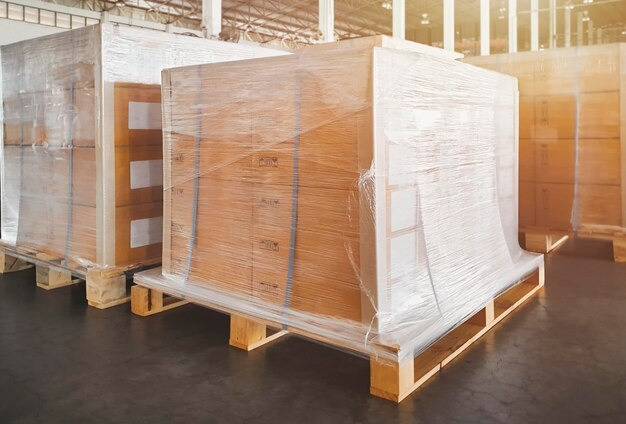Pallets are flat platforms that are used to store, transport, and handle goods in bulk. They are one of the most common and essential tools in logistics and supply chain management, as they enable efficient loading, unloading, stacking, and moving of goods. The right dimensions of a Pallet can also help to protect the goods from damage, contamination, and theft, and facilitate inventory management and tracking.
However, not all pallets are the same. There are different types of pallets that are designed for different purposes, and they have different dimensions, specifications, materials, and construction. Choosing the right pallet for your needs can have a significant impact on the performance, cost, and sustainability of your logistics and supply chain operations. In this article, we will explain the main factors that you need to consider when selecting a pallet, and provide some examples of common pallet types and their dimensions.
Types of Pallets and Their Uses

There are many ways to classify pallets, but one of the most common and practical ways is based on their shape and design. According to this criterion, there are two main types of pallets: stringer pallets and block pallets.
- Stringer pallets are the most widely used type of pallets in the world. They have three or more parallel pieces of wood (called stringers) that support the top and bottom deck boards. Stringer pallets can be either two-way or four-way, depending on whether they can be lifted and moved by a forklift from two or four sides, respectively. Stringer pallets are usually cheaper and lighter than block pallets, but they are also less durable and stable.
- Block pallets are more robust and versatile than stringer pallets. They have four or more blocks of wood (called blocks) that support the top and bottom deck boards. Block pallets are usually four-way, meaning that they can be lifted and moved by a forklift from any side. Block pallets are also more suitable for automated handling systems, as they have more uniform dimensions and better alignment. Block pallets are usually more expensive and heavier than stringer pallets, but they are also more durable and stable.
Another way to classify pallets is based on their intended use and reuse. According to this criterion, there are three main types of pallets: single-use pallets, reusable pallets, and pooling pallets.
- Single-use pallets are also known as one-way pallets or disposable pallets. They are designed to be used only once for a specific shipment, and then discarded or recycled. Single-use pallets are usually made of low-quality wood or other cheap materials, and they have minimal specifications and standards. Single-use pallets are often used for exporting goods to countries that have strict quarantine regulations, as they do not require treatment or certification. Single-use pallets are usually the cheapest and lightest type of pallets, but they are also the most wasteful and environmentally unfriendly.
- Reusable pallets are also known as multi-use pallets or durable pallets. They are designed to be used multiple times for different shipments, and then repaired or refurbished. Reusable pallets are usually made of high-quality wood or other durable materials, and they have strict specifications and standards. Reusable pallets are often used for domestic or regional transportation, as they offer better performance and lower costs in the long run. Reusable pallets are usually more expensive and heavier than single-use pallets, but they are also more efficient and environmentally friendly.
- Pooling pallets are a special type of reusable pallets that are owned and managed by a third-party company (called a pallet pooler). Pooling pallets are rented or leased to customers who need them for their shipments, and then collected and returned to the pallet pooler after use. Pooling pallets are usually made of high-quality wood or other durable materials, and they have standardized specifications and markings. Pooling pallets are often used for international or intercontinental transportation, as they offer better convenience and quality control. Pooling pallets are usually the most expensive and heaviest type of pallets, but they are also the most reliable and sustainable.
Understanding Pallet Dimensions and Specifications

Pallet dimensions and specifications are important factors that affect the efficiency, safety, and compatibility of pallets in logistics and supply chain management. Pallet dimensions and specifications include the following aspects:
- Length and width: These are the horizontal dimensions of the pallet, measured from edge to edge. Length and width determine the size and shape of the pallet, and how many pallets can fit in a given space or container. Length and width are usually expressed in inches or centimeters.
- Height: This is the vertical dimension of the pallet, measured from the bottom to the top. Height determines the clearance and stacking ability of the pallet, and how much space it occupies in a given height or volume. Height is usually expressed in inches or centimeters.
- Weight: This is the mass of the pallet itself, without any load. Weight determines the load-bearing capacity and handling difficulty of the pallet, and how much it adds to the total weight of the shipment. Weight is usually expressed in pounds or kilograms.
- Load capacity: This is the maximum weight of the load that the pallet can safely support. Load capacity depends on the design, material, and condition of the pallet, as well as the distribution and orientation of the load. Load capacity is usually expressed in pounds or kilograms.
- Deck type: This is the configuration and arrangement of the deck boards on the top and bottom of the pallet. Deck type affects the stability, ventilation, and hygiene of the pallet and the load. Deck type can be either solid (with continuous boards), perforated (with gaps between boards), winged (with boards extending beyond the stringers or blocks), or reversible (with identical top and bottom decks).
- Entry type: This is the number and location of the openings on the sides of the pallet that allow the insertion of the forks of a forklift or pallet jack. Entry type affects the accessibility and maneuverability of the pallet and the load. Entry type can be either two-way (with openings on two opposite sides), four-way (with openings on all four sides), or partial four-way (with openings on all four sides, but with reduced size or clearance on two sides).
Pallet dimensions and specifications vary depending on the type, purpose, and origin of the pallet. There is no universal standard for pallet dimensions and specifications, but there are some regional and industry-specific standards that are widely used and recognized. Some of the most common pallet standards are:
- ISO 6780: This is the international standard for flat pallets for intercontinental materials handling, established by the International Organization for Standardization (ISO). It specifies six pallet sizes, ranging from 800 x 600 mm to 1219 x 1016 mm, and their corresponding codes, markings, and tolerances.
- EUR-pallet: This is the European standard for pallets used in the European Pallet Association (EPAL) pallet pool, established by the European Committee for Standardization (CEN). It specifies a pallet size of 1200 x 800 mm, and its corresponding code, marking, and quality.
- UIC 435-2: This is the European standard for pallets used in the International Union of Railways (UIC) pallet pool, established by the UIC. It specifies a pallet size of 1200 x 1000 mm, and its corresponding code, marking, and quality.
- GMA: This is the North American standard for pallets used in the Grocery Manufacturers Association (GMA) pallet pool, established by the GMA. It specifies a pallet size of 48 x 40 inches, and its corresponding
- Plastic pallets can be made of various types of plastic, such as high-density polyethylene (HDPE), polypropylene (PP), or recycled plastic. Plastic pallets are suitable for applications that require high hygiene, durability, and weather resistance, such as food, pharmaceutical, or chemical industries. Plastic pallets have some advantages, such as being easy to clean, resistant to damage, infestation, and fire, and compatible with automated systems. Plastic pallets also have some drawbacks, such as being expensive, difficult to repair, and potentially harmful to the environment if not recycled properly.
- Metal: This is the third most common material for pallets, as it is very strong, durable, and recyclable. Metal pallets can be made of steel, aluminum, or other alloys, and can be welded, riveted, or bolted. Metal pallets are suitable for applications that require high load capacity, stability, and security, such as heavy or valuable goods. Metal pallets have some advantages, such as being easy to maintain, resistant to damage, infestation, and fire, and compatible with automated systems. Metal pallets also have some drawbacks, such as being very heavy, expensive, noisy, and prone to corrosion and rust.
- Paper: This is the least common material for pallets, as it is relatively new and innovative. Paper pallets can be made of corrugated cardboard, honeycomb paper, or molded pulp, and can be glued, stapled, or pressed. Paper pallets are suitable for applications that require low weight, low cost, and high recyclability, such as light or disposable goods. Paper pallets have some advantages, such as being very light, cheap, biodegradable, and compliant with international trade regulations. Paper pallets also have some drawbacks, such as being weak, fragile, and susceptible to moisture and fire.
Pallet materials have a significant impact on the durability and sustainability of pallets in logistics and supply chain management. Durability refers to the ability of the pallet to withstand wear and tear, and to maintain its functionality and quality over time. Sustainability refers to the environmental impact of the pallet, in terms of its resource consumption, waste generation, and carbon footprint. Different pallet materials have different levels of durability and sustainability, depending on their properties, production, and disposal. The following table summarizes the main characteristics and trade-offs of the four pallet materials:
| Material | Durability | Sustainability |
|---|---|---|
| Wood | Medium | Medium |
| Plastic | High | Low |
| Metal | High | Medium |
| Paper | Low | High |
Pallet Design and Construction Considerations

Pallet design and construction are also important factors that affect the functionality, quality, and safety of pallets in logistics and supply chain management. Pallet design and construction include the following aspects:
- Nails: These are the metal fasteners that are used to join the pallet components, such as the stringers, blocks, and deck boards. Nails affect the strength, stability, and durability of the pallet, and how easily it can be repaired or recycled. Nails can be either spiral (with twisted shanks), ring (with annular shanks), or smooth (with plain shanks). Spiral and ring nails have better holding power and resistance to withdrawal than smooth nails, but they are also more difficult to remove and recycle. Nails can also have different lengths, diameters, and coatings, depending on the type and size of the pallet components.
- Clips: These are the metal or plastic devices that are used to reinforce the corners or edges of the pallet, and to prevent the deck boards from splitting or cracking. Clips affect the durability, stability, and hygiene of the pallet, and how easily it can be cleaned or recycled. Clips can be either angle (with right-angled shapes), edge (with flat shapes), or corner (with triangular shapes). Angle and edge clips have better protection and reinforcement than corner clips, but they are also more expensive and heavier. Clips can also have different sizes, shapes, and materials, depending on the type and size of the pallet components.
- Chamfers: These are the angled cuts that are made on the bottom edges of the deck boards, to facilitate the entry and exit of the forks of a forklift or pallet jack. Chamfers affect the accessibility and maneuverability of the pallet and the load, and how smoothly it can be handled and moved. Chamfers can be either single (with one angled cut on one edge), double (with two angled cuts on both edges), or none (with no angled cuts). Single and double chamfers have better entry and exit than no chamfers, but they also reduce the contact area and load capacity of the pallet. Chamfers can also have different angles, depths, and lengths, depending on the type and size of the pallet components.
Pallet design and construction have a significant impact on the functionality, quality, and safety of pallets in logistics and supply chain management. Functionality refers to the ability of the pallet to perform its intended purpose, and to meet the requirements and expectations of the customers and users. Quality refers to the degree of excellence and consistency of the pallet, and how well it conforms to the specifications and standards. Safety refers to the degree of risk and hazard that the pallet poses to the people, goods, and environment involved in its use and handling. Different pallet designs and constructions have different levels of functionality, quality, and safety, depending on their features, benefits, and drawbacks. The following table summarizes the main characteristics and trade-offs of the three pallet design and construction aspects:
| Aspect | Functionality | Quality | Safety |
|---|---|---|---|
| Nails | Medium | Medium | Low |
| Clips | High | High | High |
| Chamfers | High | Low | Medium |
Pallet Weight Capacity and Load Distribution

Pallet weight capacity and load distribution are also important factors that affect the performance, efficiency, and reliability of pallets in logistics and supply chain management. Pallet weight capacity and load distribution include the following aspects:
- Static load: This is the maximum weight of the load that the pallet can safely support when it is resting on a flat and solid surface, such as the floor or the ground. Static load affects the storage and stacking ability of the pallet and the load, and how much space they occupy in a given area or volume. Static load is usually expressed in pounds or kilograms.
- Dynamic load: This is the maximum weight of the load that the pallet can safely support when it is being lifted and moved by a forklift or pallet jack, or when it is being transported by a truck or a plane. Dynamic load affects the handling and moving ability of the pallet and the load, and how smoothly and securely they can be transferred and delivered. Dynamic load is usually expressed in pounds or kilograms.
- Racking load: This is the maximum weight of the load that the pallet can safely support when it is placed on a rack or a shelf, with only two or four points of contact. Racking load affects the storage and stacking ability of the pallet and the load, and how much space they occupy in a given height or volume. Racking load is usually expressed in pounds or kilograms.
- Load distribution: This is the way that the weight of the load is spread and balanced on the pallet, and how it affects the stability and alignment of the pallet and the load. Load distribution affects the performance, efficiency, and reliability of the pallet and the load, and how well they can withstand stress and strain. Load distribution can be either uniform (with equal weight on all parts of the pallet), centered (with more weight on the center of the pallet), or offset (with more weight on one side or corner of the pallet).
Pallet weight capacity and load distribution have a significant impact on the performance, efficiency, and reliability of pallets in logistics and supply chain management. Performance refers to the ability of the pallet to support and carry the load, and to resist deformation and damage. Efficiency refers to the ability of the pallet to optimize the use of space and resources, and to reduce the cost and time of the operation. Reliability refers to the ability of the pallet to maintain its functionality and quality, and to avoid failure and error. Different pallet weight capacities and load distributions have different levels of performance, efficiency, and reliability, depending on their values, ratios, and variations. The following table summarizes the main characteristics and trade-offs of the four pallet weight capacity and load distribution aspects:
| Aspect | Performance | Efficiency | Reliability |
|---|---|---|---|
| Static load | High | Low | High |
| Dynamic load | Medium | Medium | Medium |
| Racking load | Low | High | Low |
| Load distribution | Medium | Medium | Medium |
Conclusion
Pallets are flat platforms that are used to store, transport, and handle goods in bulk. They are one of the most common and essential tools in logistics and supply chain management, as they enable efficient loading, unloading, stacking, and moving of goods. Pallets also help to protect the goods from damage, contamination, and theft, and facilitate inventory management and tracking.




